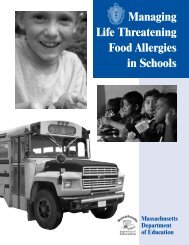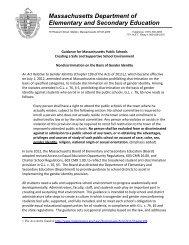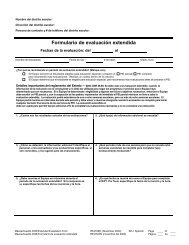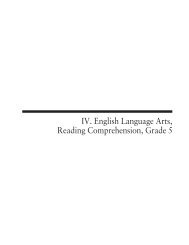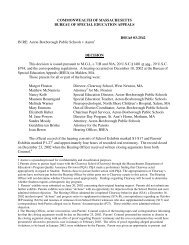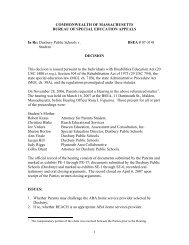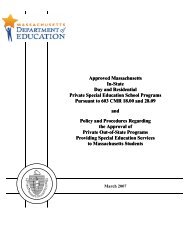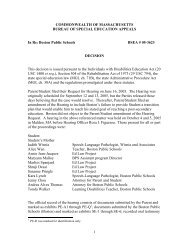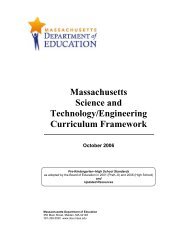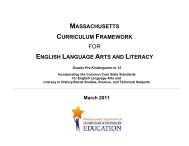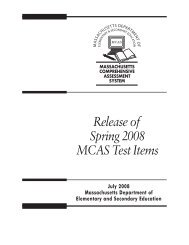2013 Educator's Manual for MCAS-Alt - Massachusetts Department ...
2013 Educator's Manual for MCAS-Alt - Massachusetts Department ...
2013 Educator's Manual for MCAS-Alt - Massachusetts Department ...
You also want an ePaper? Increase the reach of your titles
YUMPU automatically turns print PDFs into web optimized ePapers that Google loves.
The requirements <strong>for</strong> “grade-level” portfolios in each grade and subject are described below, including<br />
required content areas, strands, and standards. Use the guidelines on the previous page together with the<br />
following in<strong>for</strong>mation to prepare each “grade-level” portfolio.<br />
In ELA, <strong>for</strong> students in grade 3, 5, 6, or 8:<br />
• Any three learning standards (at the teacher’s discretion) in General Standard (GS) 4 at the<br />
student’s grade<br />
• Any three learning standards in GS 8 (at the teacher’s discretion) at the student’s grade<br />
• Any three learning standards (at the teacher’s discretion) in any additional Reading and<br />
Literature standards selected by the teacher (i.e., GS 9–18). (GS 7 Grade 3 only)<br />
In ELA, <strong>for</strong> students in grade 4 or 7:<br />
• Any three learning standards (at the teacher’s discretion) in General Standard 4 in the<br />
student’s grade<br />
• Any three learning standards (at the teacher’s discretion) in General Standard 8 in the<br />
student’s grade<br />
• Any three learning standards (at the teacher’s discretion) in the Composition strand (i.e., GS<br />
19–25). (Note: Use of a teacher-designed scoring rubric <strong>for</strong> writing is encouraged to<br />
determine the percent of accuracy and independence. See page 41 <strong>for</strong> a sample writing rubric)<br />
Sample ELA strand (GS 4) in a “grade-level” portfolio <strong>for</strong> a student in grade 3:<br />
The student’s portfolio <strong>for</strong> ELA General Standard 4 might include the following sample<br />
classroom activities and evidence:<br />
GS 4.11 Identify the meaning of common idioms and figurative phrases.<br />
— Data chart showing the student’s per<strong>for</strong>mance (percent of accuracy and<br />
independence) defining the meaning of common idiomatic expressions<br />
— Work sample: After reading Amelia Bedelia, student identified ten idioms,<br />
wrote their literal interpretations, and illustrated the actual meaning.<br />
— Work sample: After reading Wayside School, student identified five<br />
figurative phrases and created a “matching game” <strong>for</strong> peers to match<br />
figurative phrases with their meanings.<br />
GS 4.15 Determine meaning of words and alternate word choices using a<br />
dictionary or thesaurus.<br />
— Data chart showing the student’s per<strong>for</strong>mance (percent of accuracy and<br />
independence) in defining new vocabulary taken from texts read by the<br />
student<br />
— Work sample: During a lesson on life science, student used a dictionary to<br />
write definitions of new vocabulary.<br />
— Work sample: After teacher reads a passage containing vocabulary errors,<br />
student uses a thesaurus to make appropriate changes to the text.<br />
(Continued on next page)<br />
MASSACHUSETTS COMPREHENSIVE ASSESSMENT SYSTEM<br />
<strong>2013</strong> Educator’s <strong>Manual</strong> <strong>for</strong> <strong>MCAS</strong>-<strong>Alt</strong><br />
21



